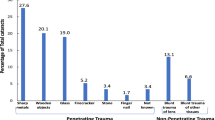Abstract
Purpose
To report treatment of pediatric patients with cataract, and evaluate the efficiency of different surgical interventions.
Method
This study comprised a consecutive series of pediatric patients with congenital or developing cataract who received surgery between 1993 and 2002 at Chang Gung Memorial Hospital in Taiwan. Patients’ demographics, cataract type, presenting symptoms, surgical intervention, postoperative visual acuity, and follow-up refractive changes were recorded.
Results
Three hundred and ninety-nine eyes of 246 children were included; unilateral cataract was present 21.8% of the eyes. The age at surgery was ranged from 1 to 157 months. Eyes were grouped by surgical interventions performed: Group 1 included 98 eyes that had lensectomy. Group 2 included 89 eyes that had lensectomy and secondary intraocular lens implantation. Group 3 included 212 eyes that had lensectomy with primary intraocular implantation. The mean follow up time was 41.3 months. Finally, 23.1% group 1 patients, 42.1% group 2 patients, and 63.4% group 3 patients achieved visual acuity better than 20/60 (P=0.000). Upon analysis with multifactor regression, age at onset (P=0.011) was the only significant factor related to visual outcome. Complications such as after cataract and glaucoma occurred in 21.6% and 5.8% of all patients, respectively.
Conclusions
Intraocular lens implantation for children with congenital or developing cataract is an effective treatment for visual rehabilitation, even for those patients age 2 years and younger.

Similar content being viewed by others
References
Ainsworth JR, Cohen S, Levin AV, Rootman DS (1997) Pediatric cataract management with variations in surgical technique and aphakic optical correction. Ophthalmology 104:1096–1101
Autrata R, Rehurek J, Vodickova K (2005) Visual results after primary intraocular lens implantation or contact lens correction for aphakia in the first year of life. Ophthalmologica 219:72–79
BenEzra D, Rose L (1990) Intraocular versus contact lenses for the correction of aphakia in unilateral congenital and developmental cataracts. Eur J Implant Refract Surg 2:303–307
Foster A, Gilbert C, Rahi J (1997) Epidemiology of cataract in childhood: a global perspective. J Cataract Refract Surg 23:601–604
Gimbel HV, Basti S, Ferensowicz M, Debroff BM (1997) Results of bilateral cataract extraction with posterior chamber intraocular lens implantation in children. Ophthalmology 104:1737–1743
Gordon RA, Donzis PB (1985) Refractive development of the human eye. Arch Opthalmol 103:785–789
Guo S, Wagner RS, Caputo A (2004) Management of the anterior and posterior lens capsules and vitreous in pediatric cataract surgery. J Pediatr Ophthalmol Strabismus 41:330–337
Hamid A, Mohammad AJ (2001) Intra-ocular lens implantation in children. Curr Opin Ophthalmol 1:30–34
Hiles DA (1990) Visual rehabilitation of aphakic children. III. Intraocular lenses. Surv Ophthalmol 34:371–379
Holmstrom G, Speedwell L, Taylor D (1990) Contact lenses—still the only solution for infant aphakia. Eur J Implant Refract Surg 2:265–267
Lambert SR, Lynn M, Drews-Botsch C, DuBois L, Wilson ME, Plager DA, Wheeler DT, Christiansen SP. Crouch ER. Buckley EG. Stager D Jr, Donahue SP (2003) Intraocular lens implantation during infancy: perceptions of parents and the American Association for Pediatric Ophthalmology and Strabismus members. J AAPOS 7:400–405
Lambert SR, Lynn M, Drews-Botsch C, Loupe D, Plager DA, Medow NB, Wilson ME, Buckley EG, Drack AV, Fawcett SL (2001) A comparison of grating visual acuity, strabismus, and reoperation outcomes among children with aphakia and pseudophakia after unilateral cataract surgery during the first six months of life. J AAPOS 5:70–75
Lesueur LC, Arne JL, Chapotot EC, Thouvenin D, Malecaze F (1998) Visual outcome after paediatric cataract surgery: is age a major factor? Br J Opthalmol 82:1022–1025
Neumann D, Weissmann BA, Isenberg SJ, Rosenbaum AL, Bateman JB (1993) The effectiveness of daily wear contact lenses for correction of infantile aphakia. Arch Ophthalmol 111:927–930
O’Keefe M, Fenton S, Lanigan B (2001) Visual outcomes and complications of posterior chamber intraocular lens implantation in the first year of life. J Cataract Refract Surg 27(12):2006–2011
O’Keefe M, Mulvihill A, Yeoh PL (2000) Visual outcomes and complications of posterior chamber intraocular lens implantation in children. J Cataract Refract Surg 26:1758–1764
Parks MM (1982) Visual results in aphakic children. Am J Opthalmol 94:441–449
Parks MM, Johnson DA, Reed GW (1993) Long-term visual results and complications in children with aphakia. A function of cataract type. Ophthalmology 100:826–841
Rabiah PK (2004) Frequency and predictors of glaucoma after pediatric cataract surgery. Am J Ophthalmol 137:30–37
Ram J, Brar GS, Kaushik S, Gupta A, Gupta A (2003) Role of posterior capsulotomy with vitrectomy and intraocular lens design and material in reducing posterior capsule opacification after pediatric cataract surgery. J Cataract Refract Surg 29:1579–1584
Robb RM, Petersen RA (1992) Outcome of treatment for bilateral congenital cataract. Ophthalmic Surg 23:650–656
Simons B, Siatkowski RM, Schiffman JC, Flynn JT, Capo H, Munoz M (1999) Surgical technique, visual outcome, and complications of pediatric intraocular lens implantation. J Pediatr Ophthalmol Strabismus 36:118–124
Speeg-Schatz C, Flament J, Weissrock M (2005) Congenital cataract extraction with primary aphakia and secondary intraocular lens implantation in the ciliary sulcus. J Cataract Refract Surg 31:750–756
Vishwanath M, Cheong-Leen R, Taylor D, Russell-Eggitt I, Rahi J (2004) Is early surgery for congenital cataract a risk factor for glaucoma? Br J Ophthalmol 88:905–910
Wilson ME Jr, Bartholomew LR, Trivedi RH (2003) Pediatric cataract surgery and intraocular lens implantation: practice styles and preferences of the 2001 ASCRS and AAPOS memberships. J Cataract Refract Surg 29:1811–1820
Author information
Authors and Affiliations
Corresponding author
Rights and permissions
About this article
Cite this article
Yang, ML., Hou, CH., Lee, JS. et al. Clinical characteristics and surgical outcomes of pediatric cataract in Taiwan. Graefe's Arch Clin Exp Ophthalmo 244, 1485–1490 (2006). https://doi.org/10.1007/s00417-006-0308-4
Received:
Revised:
Accepted:
Published:
Issue Date:
DOI: https://doi.org/10.1007/s00417-006-0308-4




